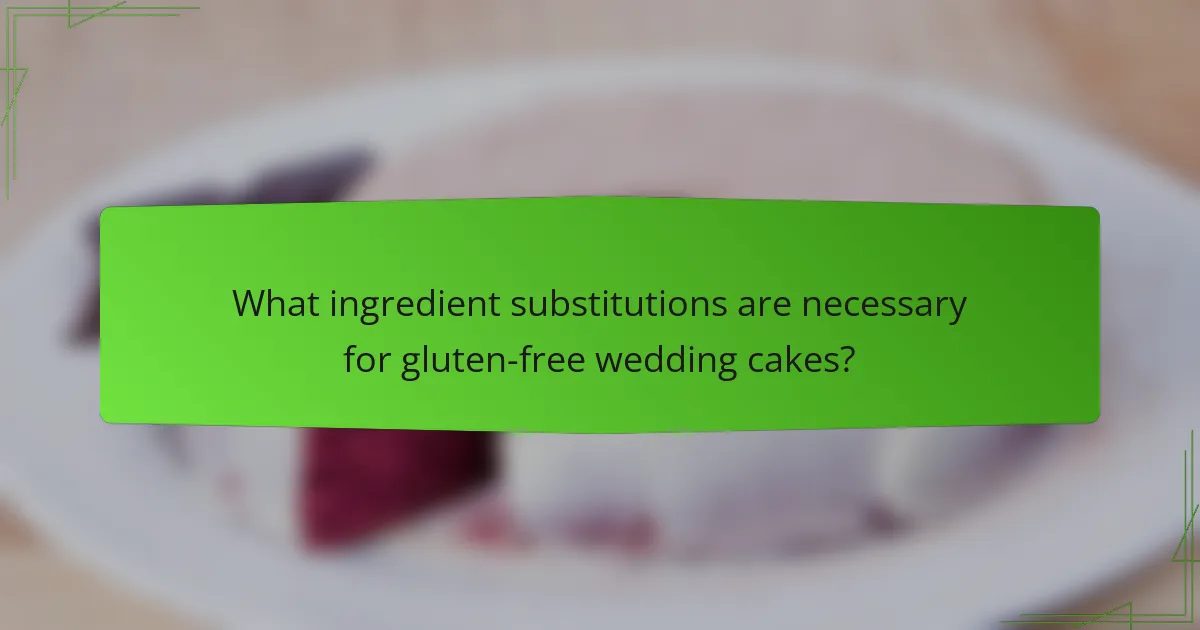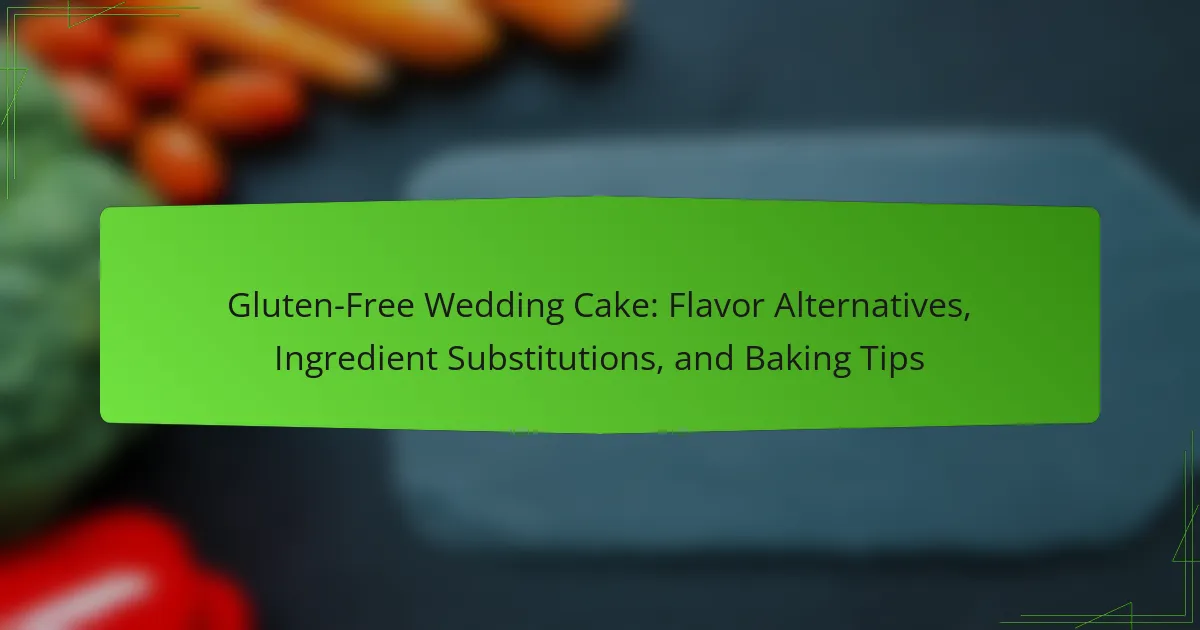
What is a Gluten-Free Wedding Cake?
A gluten-free wedding cake is a cake made without wheat or gluten-containing ingredients. It is designed for individuals with celiac disease or gluten intolerance. Gluten-free flours, such as almond, coconut, or rice flour, are commonly used in these cakes. These alternatives provide texture and flavor while avoiding gluten. Gluten-free wedding cakes can be just as delicious as traditional cakes. Many bakeries specialize in creating gluten-free options that meet dietary needs. The demand for gluten-free wedding cakes has increased as awareness of gluten sensitivities grows.
Why choose a gluten-free wedding cake for your special day?
Choosing a gluten-free wedding cake ensures that all guests can enjoy it, including those with gluten sensitivities or celiac disease. Approximately 1 in 100 people worldwide are affected by celiac disease, making gluten-free options essential for inclusivity. Gluten-free cakes can be just as delicious and visually appealing as traditional cakes. Many gluten-free flours, such as almond or coconut flour, provide unique flavors and textures. These alternative ingredients can enhance the overall taste experience. Additionally, gluten-free cakes often incorporate fresh fruits and natural sweeteners, contributing to a healthier dessert option. Offering a gluten-free wedding cake reflects a thoughtful approach to guest dietary needs. This choice can also create a memorable and unique cake that stands out on your special day.
What are the reasons couples opt for gluten-free options?
Couples opt for gluten-free options primarily due to health considerations. Many individuals have gluten sensitivities or celiac disease, making gluten-free diets necessary for their well-being. Additionally, some couples choose gluten-free options to accommodate guests with dietary restrictions. This inclusivity fosters a welcoming environment at events. Health trends also influence couples, as gluten-free diets are often perceived as healthier. Some believe that gluten-free foods can lead to better digestion and increased energy levels. Research indicates that gluten-free diets can help reduce inflammation for those with gluten intolerance. These reasons collectively drive couples to select gluten-free options for their celebrations.
How does gluten-free baking differ from traditional baking?
Gluten-free baking differs from traditional baking primarily due to the absence of gluten. Gluten provides structure and elasticity in baked goods. In gluten-free baking, alternative flours are used, such as almond, coconut, or rice flour. These flours do not behave like wheat flour, requiring different ratios and combinations. Binders like xanthan gum or psyllium husk are often added to mimic gluten’s properties. The moisture content may also need adjustment since gluten-free flours can absorb more liquid. Additionally, gluten-free baked goods may have a different texture and flavor profile compared to their traditional counterparts. These differences necessitate unique techniques and ingredient choices to achieve desirable results.
What are the key elements of a gluten-free wedding cake?
The key elements of a gluten-free wedding cake include gluten-free flour, binding agents, and flavor enhancers. Gluten-free flour alternatives like almond flour or rice flour are essential. Binding agents such as eggs or xanthan gum help maintain structure. Flavor enhancers like vanilla extract or citrus zest elevate taste. Additionally, moisture-retaining ingredients like yogurt or applesauce improve texture. Frosting options must also be gluten-free, using ingredients like butter, cream cheese, or gluten-free powdered sugar. These components ensure a delicious and structurally sound cake suitable for gluten-sensitive guests.
What types of gluten-free flours can be used?
Almond flour, coconut flour, and rice flour are popular types of gluten-free flours. Almond flour is made from finely ground almonds. It has a slightly nutty flavor and is rich in healthy fats. Coconut flour is made from dried coconut meat. It is high in fiber and absorbs a lot of moisture. Rice flour is made from ground white or brown rice. It has a neutral taste and is often used in gluten-free baking. Other options include oat flour, chickpea flour, and tapioca flour. Oat flour is made from ground oats and provides a mild flavor. Chickpea flour is made from ground chickpeas and is high in protein. Tapioca flour is derived from cassava and adds chewiness to baked goods. These flours can be used alone or in combination to create a gluten-free wedding cake.
How do gluten-free ingredients impact flavor and texture?
Gluten-free ingredients significantly alter the flavor and texture of baked goods. They often lack the elasticity and structure provided by gluten. This can result in a denser texture compared to traditional cakes. Common gluten-free flours, such as almond or coconut flour, impart distinct flavors. For instance, almond flour adds a nutty taste, while coconut flour can lend a subtle sweetness.
The absence of gluten can lead to a crumbly texture if not properly balanced with binding agents. Ingredients like xanthan gum or psyllium husk are frequently used to improve texture. These binders help mimic the properties of gluten, enhancing moisture retention and chewiness.
Research indicates that using a blend of gluten-free flours can improve overall flavor and texture. A study by the Journal of Food Science found that cakes made with a combination of gluten-free flours had better sensory qualities than those made with a single type. This highlights the importance of ingredient selection in gluten-free baking.

What flavor alternatives are available for gluten-free wedding cakes?
Common flavor alternatives for gluten-free wedding cakes include vanilla, chocolate, lemon, and almond. These flavors are popular choices that cater to various palates. Additionally, unique options like red velvet, carrot, and coconut can enhance the cake’s appeal. Many bakers use gluten-free flour blends to maintain texture while incorporating these flavors. Seasonal flavors such as pumpkin spice or berry can also be utilized. Each flavor can be complemented with gluten-free frostings, like cream cheese or buttercream. This variety allows couples to personalize their wedding cake according to their taste preferences.
Which popular flavors work well in gluten-free cakes?
Popular flavors that work well in gluten-free cakes include vanilla, chocolate, lemon, and almond. Vanilla provides a classic taste that complements various ingredients. Chocolate adds richness and depth, making it a favorite for many. Lemon offers a refreshing citrus note, brightening the cake’s flavor profile. Almond introduces a unique nutty essence that enhances sweetness. These flavors are widely used in gluten-free baking, ensuring delicious results while accommodating dietary restrictions.
How can you incorporate fruits and spices for added flavor?
Incorporating fruits and spices for added flavor in gluten-free wedding cakes can enhance taste significantly. Use pureed fruits like applesauce or mashed bananas as moistening agents. These fruits also add natural sweetness. Spices such as cinnamon, nutmeg, and vanilla extract can be added for warmth and depth. Fresh fruits can be included as toppings or mixed into the batter. Dried fruits like raisins or cranberries provide chewiness and concentrated flavor. Citrus zest from lemons or oranges brightens the overall taste profile. Each of these ingredients not only enhances flavor but also contributes to the cake’s texture and aroma.
What unique flavor combinations can enhance a gluten-free wedding cake?
Unique flavor combinations that can enhance a gluten-free wedding cake include lemon and lavender, chocolate and raspberry, and almond and orange blossom. Lemon and lavender create a refreshing and aromatic experience. Chocolate and raspberry add a rich and fruity contrast. Almond and orange blossom provide a delicate floral note. These combinations elevate the cake’s overall flavor profile. They also cater to diverse palates. Using high-quality ingredients ensures that the flavors are pronounced. Gluten-free flours like almond or coconut can complement these flavors well.
How do flavor profiles change in gluten-free baking?
Flavor profiles change in gluten-free baking due to the absence of gluten. Gluten provides structure and elasticity, influencing texture and taste. In its absence, alternative flours like almond, coconut, or rice flour are often used. These flours contribute distinct flavors and textures. For instance, almond flour adds a nutty taste, while coconut flour can impart sweetness. The moisture retention differs as well, affecting overall flavor. Additionally, the leavening agents may require adjustments, altering the final product’s flavor. These changes necessitate careful balancing of ingredients to achieve desired taste and texture.
What adjustments are needed to achieve desired flavors?
Adjustments needed to achieve desired flavors in gluten-free wedding cakes include altering ingredient ratios and selecting appropriate substitutes. For example, using a combination of gluten-free flours enhances texture and flavor. Almond flour adds richness, while coconut flour provides moisture. Incorporating flavor enhancers like vanilla extract or citrus zest can elevate the taste profile. Additionally, adjusting the sugar content can balance sweetness and enhance other flavors. Monitoring baking time and temperature is crucial as gluten-free cakes may require different settings. These adjustments are essential for achieving a flavorful and satisfying gluten-free wedding cake.
How can flavorings and extracts be effectively used?
Flavorings and extracts can be effectively used by incorporating them into recipes at the right stages of preparation. For instance, adding vanilla extract during the mixing process enhances the overall flavor profile. Concentrated flavorings should be used sparingly, as they can overpower other ingredients.
In baking, extracts like almond or lemon can be added to the batter or frosting for depth. Flavorings can also be infused into liquids, such as creams or syrups, for a more robust taste. It is essential to consider the intensity of the flavoring; a little goes a long way.
Using high-quality extracts ensures better flavor results. For gluten-free cakes, flavorings can help mask any potential off-tastes from alternative flours. Overall, effective use involves balancing flavorings with other ingredients to achieve a harmonious taste.

What ingredient substitutions are necessary for gluten-free wedding cakes?
Gluten-free wedding cakes require specific ingredient substitutions to maintain texture and flavor. Traditional wheat flour can be replaced with gluten-free flour blends, almond flour, or coconut flour. For binding, eggs are essential; however, flaxseed meal or applesauce can serve as egg substitutes. Sugar remains the same, but alternatives like honey or maple syrup can enhance flavor. Baking powder should be gluten-free, and xanthan gum is often added to improve texture. Dairy can be substituted with almond milk or coconut milk for a dairy-free option. Each substitution maintains the cake’s integrity while catering to gluten-free dietary needs.
What are the common ingredient swaps for gluten-free baking?
Common ingredient swaps for gluten-free baking include using almond flour instead of wheat flour. Coconut flour can also replace wheat flour, but it requires more liquid. For binding, eggs are often used in place of gluten. Applesauce or mashed bananas can serve as egg substitutes in vegan recipes. Brown rice flour is a popular alternative for all-purpose flour. Tapioca flour can add chewiness and moisture. Lastly, xanthan gum is frequently used to improve texture and elasticity in gluten-free baked goods. These substitutions help achieve desirable results while maintaining a gluten-free diet.
Which binders and leavening agents are suitable for gluten-free cakes?
Suitable binders for gluten-free cakes include xanthan gum, guar gum, and psyllium husk. These binders help provide structure and moisture to the cake. Leavening agents suitable for gluten-free cakes are baking powder and baking soda. Baking powder typically contains an acid and a base, which helps cakes rise. Baking soda requires an acidic ingredient to activate its leavening properties. Xanthan gum can also enhance the texture and volume of gluten-free cakes. Research shows that using these ingredients can significantly improve the quality of gluten-free baked goods.
How do dairy alternatives fit into gluten-free recipes?
Dairy alternatives fit into gluten-free recipes by providing similar textures and flavors without gluten-containing ingredients. Common dairy alternatives include almond milk, coconut milk, and soy milk. These substitutes can replace milk, cream, or butter in recipes. They help maintain moisture and richness in baked goods. For example, almond milk can be used in cake batters without compromising the gluten-free status. Coconut cream serves as a rich alternative to heavy cream in frostings. The use of these alternatives allows for a wider range of flavors and dietary accommodations. Many gluten-free recipes specifically call for dairy alternatives to enhance taste and texture.
How can you ensure a balanced texture in gluten-free cakes?
To ensure a balanced texture in gluten-free cakes, use a combination of gluten-free flours. Blending flours like almond, coconut, and rice flour creates a more stable structure. Incorporate starches such as tapioca or potato starch for moisture and lightness. Adding eggs enhances binding and contributes to a fluffy texture. Utilizing ingredients like yogurt or buttermilk can improve moisture content. Implementing xanthan gum or guar gum helps mimic gluten’s elasticity. Baking at the correct temperature is crucial for achieving a desirable rise. These techniques collectively contribute to a balanced texture in gluten-free cakes.
What role do fats and sugars play in gluten-free baking?
Fats and sugars are essential in gluten-free baking for enhancing texture and flavor. Fats, such as butter or oils, provide moisture and richness. They help create a tender crumb, which is crucial since gluten-free flours often lack elasticity. Sugars contribute sweetness and also affect browning during baking. They help with the Maillard reaction, giving baked goods a desirable color and flavor.
Additionally, sugars retain moisture, prolonging freshness. Both fats and sugars balance the dryness of gluten-free flours, improving overall palatability. Their roles are particularly important in gluten-free recipes, where traditional binding agents are absent.
How can you prevent dryness in gluten-free cakes?
To prevent dryness in gluten-free cakes, incorporate moisture-rich ingredients. Adding applesauce or yogurt enhances moisture content. Using a combination of gluten-free flours, like almond and coconut, can improve texture. Increasing the fat content with oils or butter also helps retain moisture. Baking at a lower temperature for a longer time prevents over-drying. Additionally, covering the cake while it cools traps steam and moisture. These methods are widely recommended by gluten-free baking experts.

What are some essential baking tips for gluten-free wedding cakes?
Use a blend of gluten-free flours for better texture. Common combinations include almond flour, coconut flour, and tapioca flour. These flours provide moisture and structure. Incorporate xanthan gum or guar gum to mimic gluten’s elasticity. This helps the cake hold together.
Ensure accurate measurements to maintain balance in ingredients. Too much liquid can lead to a dense cake. Use fresh ingredients for optimal flavor and rise. Eggs play a crucial role in binding and leavening. Consider adding an extra egg for added stability.
Bake at a slightly lower temperature to prevent over-browning. Monitor baking time closely, as gluten-free cakes can bake faster. Allow the cake to cool completely before frosting. This prevents the frosting from melting. Test for doneness with a toothpick, ensuring it comes out clean.
How can you achieve the best results when baking gluten-free cakes?
To achieve the best results when baking gluten-free cakes, use a blend of gluten-free flours. Combining flours like almond, coconut, and rice flour enhances texture and flavor. Additionally, incorporate xanthan gum or guar gum to mimic gluten’s elasticity. This helps in binding the ingredients together effectively.
Use fresh ingredients for optimal taste and moisture retention. Eggs play a crucial role in providing structure and moisture, so ensure you include enough eggs based on the recipe.
Baking at the correct temperature is essential. Gluten-free cakes often require lower temperatures to prevent drying out. Monitor baking time closely, as gluten-free cakes can bake faster than traditional ones.
Let the cake cool completely before frosting. This prevents the frosting from melting and ensures better adherence. By following these steps, you can create delicious and moist gluten-free cakes.
What techniques help with moisture retention in gluten-free cakes?
To help with moisture retention in gluten-free cakes, use techniques such as incorporating moisture-rich ingredients. Ingredients like applesauce, yogurt, or buttermilk can enhance moisture. Additionally, adding fats like oil or butter can improve texture and moisture levels.
Using gluten-free flour blends that include xanthan gum or guar gum aids in moisture retention. These gums create a structure that holds moisture better. Baking at a lower temperature for a longer time can also help retain moisture.
Covering the cake with plastic wrap while cooling prevents moisture loss. Finally, consider using simple syrup to brush on layers, adding extra moisture. These methods are proven to create a more enjoyable texture in gluten-free cakes.
How can you properly layer and frost a gluten-free cake?
To properly layer and frost a gluten-free cake, start by ensuring the cake layers are completely cooled. This prevents melting or sliding of frosting. Use a serrated knife to level the tops of the cake layers for even stacking. Place the first layer on a cake stand or plate. Spread an even layer of frosting on top using a spatula. Repeat this process for additional layers. After stacking, apply a thin layer of frosting around the entire cake to seal in crumbs. This is known as a crumb coat. Chill the cake for about 30 minutes to set the crumb coat. Once set, apply a thicker layer of frosting to achieve a smooth finish. Use a spatula or cake scraper for a polished look. Gluten-free cakes can be more fragile, so handle them gently throughout the process.
What troubleshooting tips can help with gluten-free baking?
To troubleshoot gluten-free baking, ensure proper flour blends are used. A mix of gluten-free flours like almond, coconut, or rice flour can improve texture. Adjust the liquid content, as gluten-free flours often absorb more moisture. Incorporate binding agents like xanthan gum or psyllium husk to enhance structure. Monitor baking time closely, as gluten-free goods may bake faster. Use an oven thermometer to ensure accurate temperature. Allow baked goods to cool completely before slicing to improve texture. Lastly, store gluten-free items in airtight containers to maintain freshness.
How do you address common issues like crumbling or density?
To address common issues like crumbling or density in gluten-free wedding cakes, use specific ingredient adjustments. Incorporating binders such as xanthan gum or guar gum can enhance structure. These ingredients help mimic the elasticity of gluten, reducing crumbling. Additionally, using a blend of gluten-free flours can improve texture. Combining almond flour with coconut flour often yields better density.
Adjusting the moisture content is also crucial. Adding applesauce or yogurt can increase moisture, preventing dryness. Baking time and temperature adjustments can further help. Lowering the oven temperature and extending baking time allows for even cooking.
Research shows that gluten-free cakes often benefit from these modifications. A study by the University of Nebraska found that using xanthan gum improved the texture of gluten-free baked goods significantly.
What are the best practices for storing gluten-free wedding cakes?
Store gluten-free wedding cakes in an airtight container to maintain freshness. This prevents moisture loss and protects the cake from contaminants. Refrigerate the cake if it contains perishable fillings or frostings. For longer storage, freeze the cake. Wrap it tightly in plastic wrap and then in aluminum foil. This method protects against freezer burn. Thaw the cake in the refrigerator before serving. Gluten-free cakes can dry out more quickly than traditional cakes. Therefore, consume them within a few days if stored at room temperature. Proper storage ensures the best texture and flavor retention.
Gluten-free wedding cake is a cake made without wheat or gluten-containing ingredients, catering to individuals with celiac disease or gluten intolerance. The article explores the reasons couples choose gluten-free options, highlighting health considerations and the need for inclusivity among guests. It details the differences in gluten-free baking, including ingredient substitutions, key elements like binders and leavening agents, and the impact of gluten-free flours on flavor and texture. Additionally, it provides essential baking tips, troubleshooting advice, and best practices for storing gluten-free wedding cakes to ensure optimal taste and quality.
